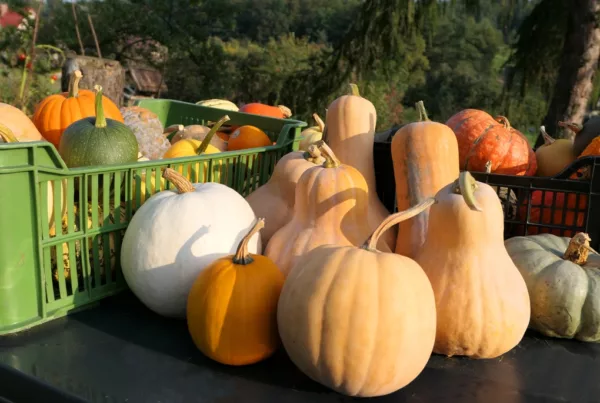Written by Nicole Holland
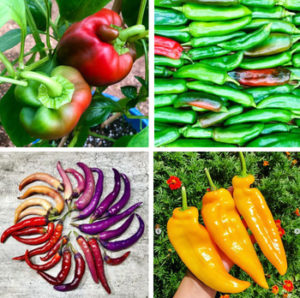 Easy to grow, peppers are perfect for any SFG. They come in a huge range of colors, shapes and spice levels. Mel said, “they look great in the garden, and some people grow several types for their ornamental virtues.” Sweet or hot, start them easily indoors from seed or buy transplants. High in vitamins A and C, peppers are relatively disease and pest free, too. More good news: the well-draining Mel’s Mix™ in your SFG will promote healthy, happy plants.
Easy to grow, peppers are perfect for any SFG. They come in a huge range of colors, shapes and spice levels. Mel said, “they look great in the garden, and some people grow several types for their ornamental virtues.” Sweet or hot, start them easily indoors from seed or buy transplants. High in vitamins A and C, peppers are relatively disease and pest free, too. More good news: the well-draining Mel’s Mix™ in your SFG will promote healthy, happy plants.
Peppers are a tender crop and need warm soil; wait at least two weeks after your last expected frost date to transplant outdoors. If growing from seed, start germination indoors about seven weeks prior to moving outside. Peppers need at least eight hours of sunlight per day, but they also benefit from a little shade during the hottest part of the day. Peppers take a long time to grow; it will be three to four months for them to fully ripen.
Water your plants at the root (like other veggies in an SFG bed), mulch in hot weather, and you’re set!
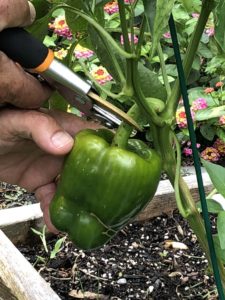 When it’s time to harvest, here’s two reminders:
When it’s time to harvest, here’s two reminders:
1) Cut the fruit from the bush. The stems and branches of peppers are brittle; don’t pull or you’ll accidentally break other branches.
2) Leave about one inch of stem on each harvested pepper for a longer storage life.
Peppers come in a wide range of colors, shapes, and spice levels with over 4,000 known varieties – and more being cultivated every day. Their heat level is measured on the Scoville Heat Unit (SHU) Scale. Currently, the Carolina Reaper sits at the top with a score of 2,200,000 SHU!
Sweet Snackers – Try These Gentle Peppers
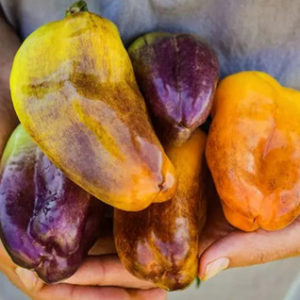
Blot Pepper. Photo credit: Baker Creed Seeds
Golden Marconi (0 SHU) – Sweet 6 to 10” peppers that start out green and ripen to a golden yellow. These flavorful peppers are better than the traditional bell varieties and are excellent raw or roasted.
Blot (0 SHU) – A sweet treat from Eastern Europe, these thick-walled fruits are crunchy, sweet, and ripen to a bright orange color with purple streaks. They are perfect for cooking, and raw on salads or sandwiches.
Lipstick (0 SHU)– These 4” long tapered peppers are early maturing and ripen to a deep red color. This extra sweet pepper is great for northern climates with shorter seasons.
Kick It Up a Notch with These Hotter Peppers
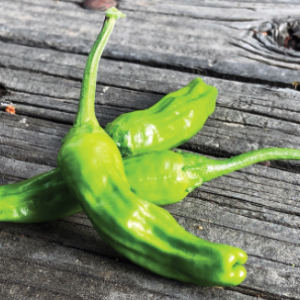
Shishito Pepper. Photo credit: Botanical Interests
Shishito (100 to 1,000 SHU) – These prolific plants produce 2 to 4” thin-skinned peppers that are delicious with just a touch of heat and a citrusy, smokey flavor. They are wonderful simply sautéed or blistered with about 1 in 10 having a bit more heat.
Padrón (500 to 2,500 SHU) – Another game of pepper roulette can be played with these hot chilies that have a mellow flavor with the occasional fiery surprise. These peppers can be prepared similar to shishito peppers and are also great pickled.
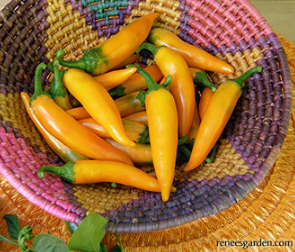
Bulgarian Carrot Peppers. Photo credit: Renee’s Garden Seeds
Bulgarian Carrot Chile Peppers (5,000 to 30,000 SHU) Also called “Shipkas,” these compact heirloom chiles bear early, 3-inch orange fruits shaped like carrots. Hot and fruity, these peppers are tasty in fresh salsas or any dish or sauce that calls for both heat and lots of flavor. Perfect for hot pickled peppers.



